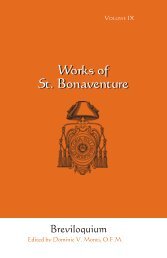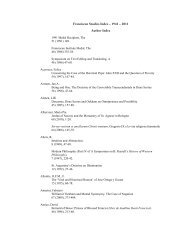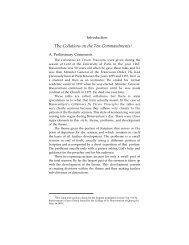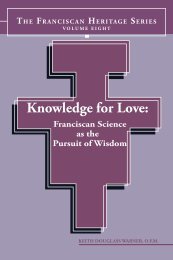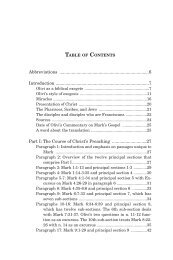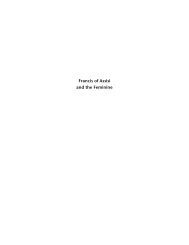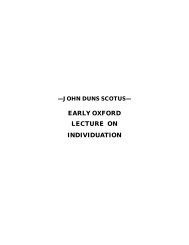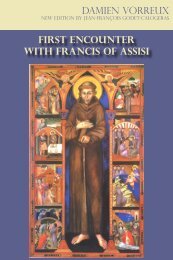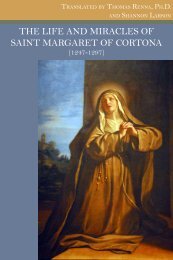FOUR QUESTIONS ON MARY - Franciscan Institute Publications
FOUR QUESTIONS ON MARY - Franciscan Institute Publications
FOUR QUESTIONS ON MARY - Franciscan Institute Publications
Create successful ePaper yourself
Turn your PDF publications into a flip-book with our unique Google optimized e-Paper software.
John Duns Scotus: Four Questions on Mary<br />
opposition, the last instant of forward motion coincides with<br />
the first instant of reverse movement and the reversal of direction<br />
takes on the time-characteristics of continuous rectilinear<br />
motion.<br />
Henry sees this as proof that there is an intermediate position<br />
between Aristotle’s opposites of continuous and discontinuous<br />
change, and because of his great devotion to Mary,<br />
he sees a way to shrink the interval between her contracting<br />
original sin and her subsequent sanctification to an absolute<br />
zero time-wise. For at one and the same instant of time, there<br />
can be two distinct “signs of nature.” 41 In one Mary’s soul contracts<br />
original sin, but in the other, she is sanctified and continues<br />
to remain in that state for her entire life. Henry maps<br />
his time-distinction on linear co-ordinates, since the flow of<br />
time is analogous to that spatial movement. Let the millstone<br />
represent the bodily flesh and the bean the spiritual soul;<br />
and let the moment the bean touches the millstone represent<br />
the instant Mary’s soul was created and infused in her body.<br />
The downward movement of the bean represents the time<br />
secundum rem, differenti solum secundum esse et rationem, ut est finis<br />
temporis mensurantis motum praecedente et principium temporis mensurantis<br />
motum sequentem. Secundo modo cum faba movetur superius motu<br />
violento, et obviat fortius moto, puta lapidi molari descendenti naturaliter<br />
inferius, in contactu lapidis subito in instanti mutata est in spatium sibi<br />
aequale per motum eius violentum sursum, et in eodem instanti ipsam faba<br />
mutatur ab illo per motum naturale lapidis deorsum fabam impellentem,<br />
ut non sit possibile eam in illo spatio sibi aequali quiscere, sicut quisceret<br />
si sibi relinqueretur, secundum aliam quandam demonstrationem Philosophi<br />
in eodem VIII, nec esse aut manere nisi per istas medium inter tempora<br />
illorum motuum in quo tamen spatio est per illud instans secundum<br />
veritatem, nec fuit in tempore praecedenti, nec tempore sequenti, et est illud<br />
instans signum commune utriusque temporis et primo et posteriori et idem<br />
et unum numero, ratione autem non idem, ut dicit Philosophus in eodem<br />
VIII. Quod si spatium illud sibi aequale et totum residuum spatii sursum<br />
obscurus esset et tenebrosum, et totum residuum spatii deorsum esset clarum<br />
et illuminatum , superficies fabae superior in illo instanti in quo esse<br />
in spatio sibi aequali esset obscura et in toto tempore sui ascensus fuisset<br />
clara et illuminata, et similiter in toto tempore sui descensus. Et valet sicut<br />
mihi videtur hoc exemplum secundum ad nostrum propositum.<br />
41 “Signum” or “sign” has the technical sense of a non-dimensional unit<br />
such as a “point” in space, or a point in time. And a distinction of signs<br />
is used to express some conceptual distinction or non-mutual implication<br />
that can be used to order things conceptually that coincide temporally.<br />
14



